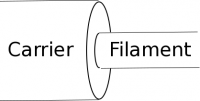Project 6A: Lightbulbs'R'Us and JPL
Continuing T.R.O.J.A.N forces collaboration with the Jet Propulsion Laboratory (JPL) Division of NASA, you and your team are working with a group of electrical engineers at Lightbulbs'R'Us. Given the problems that Lieutenant Pete “Maverick” Mitchell has been having with the warning lights, the Jet Propulsion Laboratory (JPL) Division of NASA has placed a large order for a new set of warning lights for their power delivery system. They have told you that a current of 2.5 A down the carrier wire should turn on the warning light. Unfortunately, due to JPL's time schedule, you do not have time to order LED bulbs and must construct the lightbulbs the old fashion way using a filament (very thin piece of wire, diameter = 0.1 mm) connected to the carrier wire (normal electrical wire, diameter = 1.63 mm). You happen to have the following metals in the warehouse, with known electron densities and electron mobilities.
JPL has asked for a product report on your design. They would like you to outline which metals you would want to use for carrier and filament, why you picked those metals, and the expected surface charge distribution for your set up. They would also like to know the total resistance of your design and the total voltage needed to power your bulb (so they know what kind of battery to provide).
Learning Goals:
- Describe what parts of the circuit provide power and which parts use power.
- Compare quantities like current, electric field, potential difference, and power for the thin and thick parts of the wire.
- Describe and draw the surface charge gradient for a thick and thin wire.
- Explain what is resistivity/conductivity and how it relates to resistance.
- Explain how current, voltage, and resistance are related and how you used these ideas in your solution.
Conceptual Questions:
- There are a lot of new vocab words this week. For each of these words, write out the variable, the definition (what is it in words), and the units: electron mobility, electron density, conductivity, resistivity, resistance, electron current, conventional current, voltage, power, and drift speed.
- How does the current compare in the filament and carrier wires? (Same, bigger, smaller?) How does the electric field, potential difference, and power compare for the different wires?
- What is the drift speed of the electrons in the wire? How long would it take one electron to travel the whole circuit? (You can calculate a numbers here.) Why would the lights turn on immediately when you flip a switch?
- What assumptions did you make in your solution? Why did you need them?
- What other factors might influence the choice of metal? How realistic is your solution?
